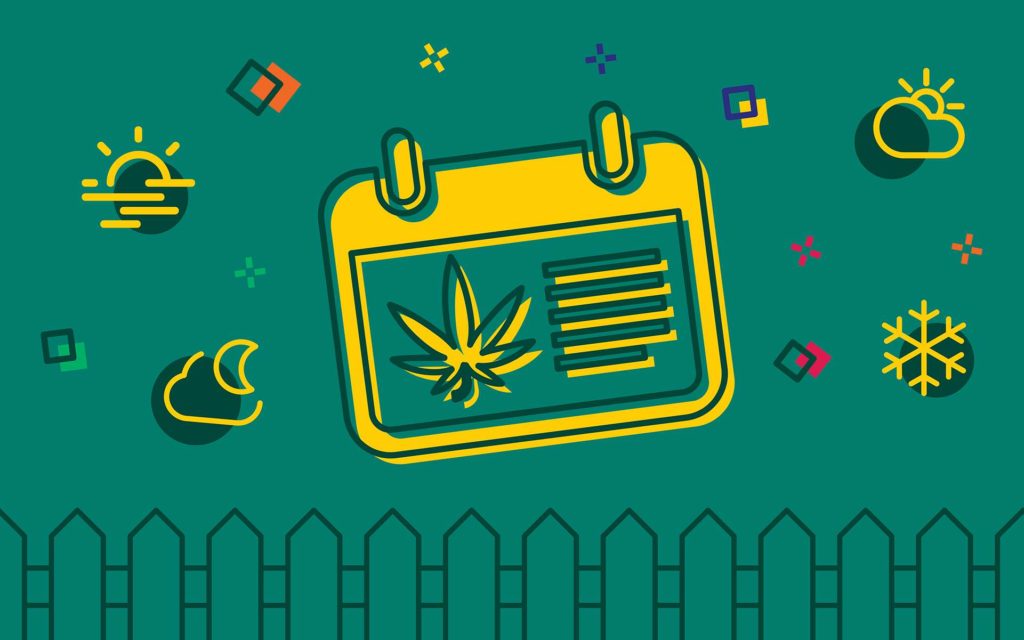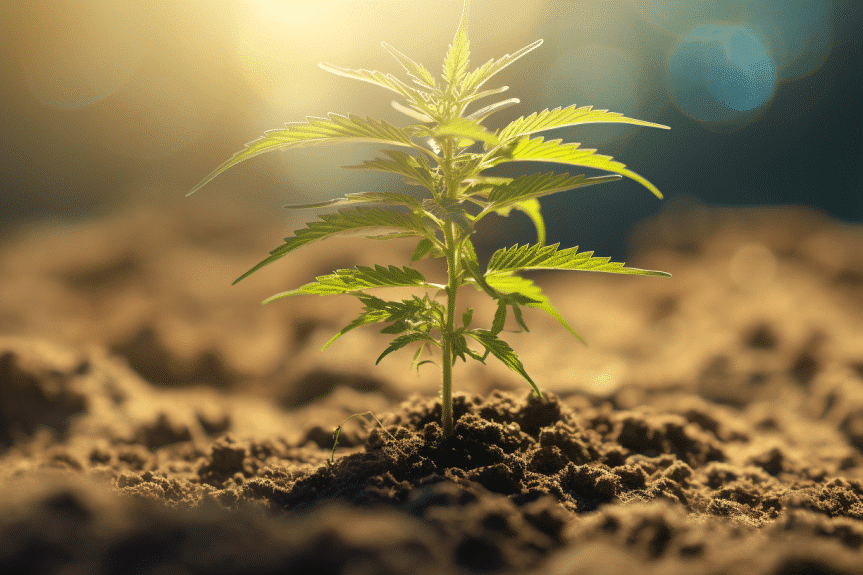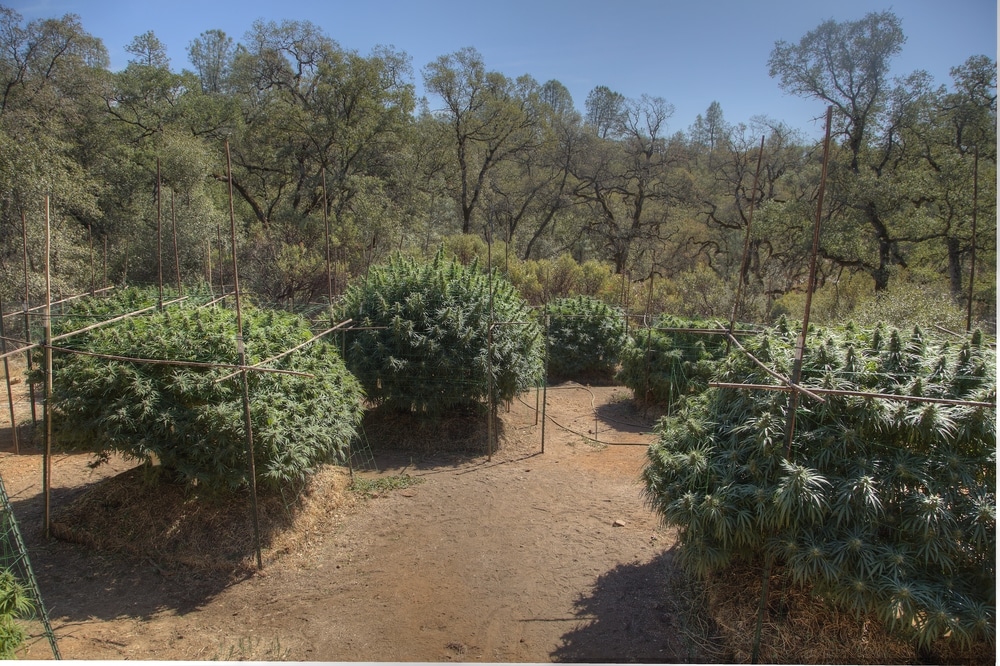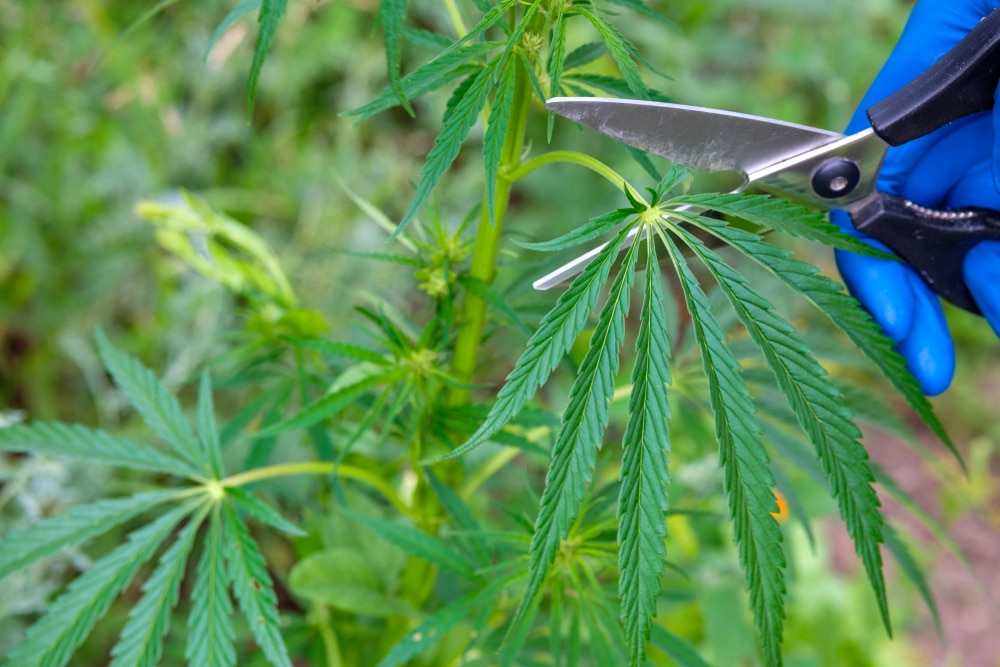No products in the cart.
Marijuana Education
What Are The Ideal Weeds Seasons For Growing
Do you have enough passion but inadequate information on the outdoor growing of marijuana? Then you’ve come to the right place for answers as you’ll find out why pro growers pay attention to the seasons to help them achieve maximum productivity. You’ll also learn which strains or species grow best in the weather in the area in which you live and the reason why growers harvest their crops in the fall. Take advantage of our full guide on Ideal Weed Seasons.
Understanding the weed seasons
Among weed-growers, weed seasons is an industry term for referring to spring, summer, and fall; seasons when cannabis plants thrive the best. It essentially refers to the preferred time for outdoor planting. It is no doubt that growing marijuana outdoors is cheaper, more economically feasible, and more environmentally sustainable than indoor growing.
This is because there would be no need for special equipment like pots, lights, and the like. In contrast, all that would be needed would be nature’s gift and the grower’s horticultural skills which will also benefit enormously from the outdoor workout. This is without having to mention the yield which will be better because of the ample space provided by the outdoor setting.
Note, however, that weed seasons differ from place to place, however, information that will be given in this article will be focused on the northern hemisphere.
Many growers begin their growing indoors from mid-march to early April to get a head start since marijuana matures and is usually harvested at most in late fall. It is important to note that this is only applicable to normal photoperiod strains as it is not advisable to move or transplant autoflowers.
Why is cannabis planted and harvested at certain times of the year?
Uncertain about when to harvest your outdoor cannabis? The answer lies in understanding the weather in your specific geographic location. Weed seasons are determined according to a region’s climate and so cannot be the same for all regions; some regions have shorter summer times and thus more humidity which is more ideal for weed growth than others.
Frost is not a friend of your plant as it is known to cause significant damage to both seedlings and fully grown plants, thus the need for proper timing and understanding of the climate to understand the shift in season and to act accordingly.
Maximum daylight during the summer is extremely beneficial to the plant during its vegetative stage, as is the uninterrupted 12 hours of light and darkness of fall equinox which is the trigger for the flowering of marijuana in September.
Strains and their preferred growing seasons
Understanding strains and their specific genetic characteristics can help a grower adapt to his specific climate conditions especially for outdoor growing. How? Indica strains are known to be better adept in handling harsher conditions and are therefore more adaptable to northern states; Sativa strains prefer the heat and humidity of the southern states and their flowering time is longer when compared to the Indica strain. The Landrace strain is the most demanding of care and attention and generally requires more time to flower.
The role of genetics in marijuana growing could never be underestimated as it determines how quickly the plant grows and if it becomes resistant to disease and in determining its yield. Nonetheless, the importance of picking a strain that is more suitable to your environmental configuration will help you to avoid spending good money on seeds only to have them die in unsuitable weather conditions.
The marijuana life cycle for outdoor farmers
We will now consider the key stages of life of a marijuana plant in a year which is five in number and its importance to an outdoor grower.
Spring (early) germination
As with all seeds, the first stage in the life of a marijuana plant is the germination of the seed. With the late fall harvest period in mind, and the need to give the plant ample time to grow and produce a high yield, it is advisable to pot the seeds from the early spring equinox. Having potted the plants, it takes around 1-5 days for it to sprout, at which point it is ready to be moved into nutrient-rich soil.
Summer (early) seedling stage
As summer arrives, it is time to move the germinated cannabis outside. This is why it is necessary to have some knowledge of the weather in your area because so long as there is the possibility of overnight frost, then it is still not safe to move the plant. As a precaution, plants should be moved outside when they’ve grown to about a foot tall as they can handle the weather better, or they could be grown in pots so that they can be moved inside when the weather becomes harsh and unfriendly.
Fall (early) vegetative stage
During the vegetative stage, the cannabis plant grows aggressively reaching the sun, and grows expansively with relation to the amount of space afforded by the farm. This is the growing season. As the topmost layer becomes very dense, topping (which is the pruning of the topmost layer) allows light to reach the lower layers of the plant.
Also, this is the time during which the male plants begin to produce pollen and pollinate leading to cross-breeds so where the grower wants only a sea of females, it is the advisable time to move the males away.
In the fall, the plant continues to thrive in the vegetative stage until the day and night ratio begins to tilt in favor of the dusk, then the plants begin to enter the flowering stage.
Fall (prepare for late fall) flowering stage
This is the most important stage for farmers as without this stage, there’ll be no buds for the harvest. At this point, the plants begin to limit their growth, and focus is redirected to the production of flowers. This stage is divided into three as follows;
- Flower Initiation: This is the first stage of flowering in the cannabis plant. The plant begins to produce white pistils as the growth of the plant itself begins to slow down.
- Mid-flowering: At this stage, the plant stops growing completely and the flowers begin to turn to buds.
- Ripening: At this point, the buds begin to swell and the white pistils begin to change their color to orange-brown in anticipation of the harvest season.
Mid-late fall harvest season
As important as it is to get the planting season right, it is also important to get it right at harvest because when not harvested on time, the buds lose their quality as THC becomes CBN. When unsure on when to harvest, cues should be taken from the plants and the buds should be harvested as the marijuana leaves begin to turn yellow or when the buds start showing orange hues.
Marijuana growing schedule
As an outdoor grower, you can never have too much information on the marijuana growth timeline. For this reason, a growth schedule has been made below for growers (or intending growers) in northern and southern states as they have slightly varying weather conditions.
Northern states: Month by month analysis of weed seasons
Before going into details, it is important to note that the northern part of the United States has a much shorter growing season than the south. Also, the states used as a yardstick for measuring the north are New York, Seattle, and Chicago.
Generally, as a northern grower, you are to keep your plant indoors till the mid parts of May. Nonetheless, there’s a lot of preparatory work to be done in anticipation of this move-out. The preparations are important because they will contribute markedly to the final yield of the plants.
February (note how the season starts in February, not January)
- Average Day Length: 9.5 – 10.5 hours; differs in Alaska which has 8.5 – 10.5 hours
- Average Temperature: 5 – 10.56 °C
Because of the extreme temperature, it is ill-advised to plant anything outdoors. It is however a perfect time to begin gathering supplies in anticipation of the forthcoming planting season. The most common items to be collected include but are not limited to; cannabis seeds, pots, preferred soil type, and alternatives.
While growing outside is not advised as it is not the best for weed seasons, it is wise to begin potting the seeds in a controlled environment indoors though towards the end of February. Also, it is the ideal time to prepare the outdoor field by adding manure.
March
- Average Day Length: 9.5 – 13 hours; differs in Alaska which has 10.5 – 13 hours.
- Average Temperature: 0.56 -12.22°C
At this point, the weather begins to pick up the temperature, and consequently, the days also start getting longer in Portland and Seattle which indicates that the growing season is getting closer. Where clones are to be used in growing, the source plant should be set towards the end of March. At any point, this is the preferred point to start sprouting the plants. Sunlight should be provided in adequate quantity and an eye should be kept on the length of days.
April
- Average Day Length: 12.5 – 14.5 hours; differs in Alaska which has 13.5 – 15.5 hours.
- Average Temperature: 1.67 – 16.67°C; differs in Alaska which is usually still quite cold with a temperature of -4.44 – 7.22°C
While it is still impossible for the Alaskan grower to even begin considering growing outdoors by this time, the vast majority of growers can begin to move their plants outside so long as they are in pots so they can be returned inside to avoid overnight frosts. Also, due to the increased availability of sunlight, artificial lighting stops being a necessity.
NOTE: that plants should be introduced to direct sunlight gradually to avoid shock and leaf burn.
May
- Average Day Length: 14 – 15.5 hours; differs in Alaska which has 15.5 – 17.5 hours.
- Average Temperature: 11.11 – 22.22°C; differs in Alaska which is usually a bit colder with a temperature of 4.44 – 16.11°C
In May, the spring season is usually in full swing and this includes places like Alaska although Alaska’s interior is still susceptible to cold. Growers in this area are usually advised to wait till late May to make any move on outdoor growing or to focus on growing autoflowers which need only three months to be fully developed.
June
- Average Day Length: 15 – 16 hours; differs in Alaska which has 18 hours.
- Average Temperature: 12.22 – 27.22°C differs in Alaska which is usually a bit colder with a temperature of 11.11 – 21.67°C
In this month, within June 18 – 24, the cannabis plant develops the most. The grower will notice rapid growth due to the warmth of the temperature. Also, it is safe for the cannabis plant to be left outside, but the grower should be conscious of pests and diseases. It is also important that the plant receives a lot of water at this stage as well as a nitrogen-rich supplement. Also, where the seeds used are not feminized, the male plants would become obvious around this time.
July
- Average Day Length: 14 – 16 hours differ in Alaska which has 16.5 – 18 hours
- Average Temperature: 14.44 – 29.44°C differs in Alaska which is usually a bit colder with a temperature of 12.78 – 22.78°C
During this period of the growing season, auto flowers grow large flower clusters. Photoperiods on the other hand begin the development of their first pistils. Where the grower had not differentiated his plants based on sex, this is the ideal time to do so, to avoid the incident of pollination. The grower is also advised to switch to bloom-boosting nutrients as this is the period when the females begin to flower.
August
- Average Day Length: 13 – 15 hours differ in Alaska which has 14 – 16.5 hours
- Average Temperature: 14.44 – 28.89°C differs in Alaska which is usually a bit colder with a temperature of 9.44 – 18.89°C
For auto flowers, this marks the beginning of the harvest season when they have to be harvested and dehydrated by hanging upside down in a dark place. This process is recommended to be carried out at room temperature and usually takes an average of ten days.
For photoperiods, it’s just another day at the office, although an important one as they begin to bloom in this period. It is then necessary for the plants to begin to receive minerals that are essential for proper budding. All very important for weed seasons.
September
- Average Day Length: 11.5 – 13.5 hours differ in Alaska which has 11.5 – 14 hours
- Average Temperature: 12 – 24.44°C differs in Alaska which is usually a bit colder with a temperature of 3.33 – 12.78°C
At this point in the weed season, the days become shorter and cooler. This temperature enhances the growth of more pistils and flowerheads. It is essential that the grower keeps them dry and protects them from the wind. Using added supports to hold them up or building makeshift shields like nets is a good idea.
Also, the grower should know that as of September ends, fall begins, and with it comes to the highly anticipated harvest.
October
- Average Day Length: 10 – 13 hours differ which has 11.5 -14 hours
- Average Temperature: 7.78°C – 17.78°C differs in Alaska which is usually a bit colder with a temperature of -6.67 – 0.56°C
At this point, fall is in full swing and the marijuana plant is at maximum bloom. This implies that the harvest season is within grasp. As it was at planting, knowing when to harvest is extremely important as leaving it too late would lead to rot wiping out an entire farm especially if the plants were grown in an area with high rainfall. It is advisable that where anomalies are detected, the buds are harvested even if early as it is preferable to have some yield than to have none at all.
Southern states: Month by month analysis of weed seasons
The north and the south have quite a few similarities in their weather. The differences while scant are quite profound as they bother on two key factors which are temperature and sunlight which are factors without which the weed plant would die.
An important fact to note is that the southern region is low lying thus; the southern region has a longer and warmer climate which results in a longer cannabis growing season. Also, due to its extended time frame, farmers are allowed to try out new strains which take longer to reach harvest.
The importance of early preparation cannot be overemphasized irrespective of the longevity of the weather thus, the February start season is recommended here.
NOTE: The temperature and daylight averages used here are based on timelines from Los Angeles, Houston, and Miami. Also, while the southern areas have more sunlight, the temperature ranges are usually lower.
February
- Average Day Length: 10.5 – 11.5 hours
- Average Temperature: 9.5 – 25°C
In the southern regions, this could be said to be the beginning of the weed growing season as the seeds can begin to be gathered and sorted out as well as supplies. Due to the extended growing season in this region, the recommended stain is the Sativa.
March
- Average Day Length: 11.5 – 12.5 hours
- Average Temperature: 10 – 25.5°C
At this point in some areas of the southern region, it begins to feel a lot like summer. The grower can begin cultivating on window sills with an eye on the weather which could still be erratic so that the plants can be brought indoors. Also, the plants should get at least 12 hours of sunlight and where this is not readily available should be augmented with artificial lighting.
Where clones are to be used, the mother plant should be given more attention as she ought to be ready as March ends.
April
- Average Day Length: 12.5 – 13.5 hours
- Average Temperature: 12.5 – 26.9°C
Except in places like Hawaii, April comes with increased temperature and markedly longer days. At this point, the grower can wean his plants of artificial lighting as the plants would get at least 13 hours of light from the sun. In southeastern regions, growers can move their plants out to receive air as far as they are taken in at night.
Where autoflowers were used and already germinated, the grower could even have two harvests in the outdoor growing season.
May
- Average Day Length: 13 – 14.5 hours
- Average Temperature: 14.9 – 28.5°C
May comes with spring and with enough daylight for the whole vegetative stage and the weather is clement enough that the plants can be moved out permanently. Where autoflowers were the grower’s choice, mid-May is the time to move them outdoors permanently too.
For growers in Hawaii, they should know that they have shorter days so strains that need more than average sunlight shouldn’t be used.
June
- Average Day Length: 14.5 average
- Average Temperature: 14.9 – 30.5
This point of the growing season guarantees the longest days and thus plants that had been moved outside in May begin to develop quickly.
For autoflowers, this is the beginning of the bloom season but for photoperiods, their growth is accelerated. At this point, the grower’s nutrients applied to the plant should be rich in nitrogen for the sustenance of the high vegetative growth.
Also at this point, non-feminized cannabis plants begin to show their sex and should be removed immediately to avoid pollination.
July
- Average Day Length: 13.5 – 14.5 hours
- Average Temperature: 17.5 – 31.5°C
Of all the months in the growing season, July is the warmest. In this month, photoperiods begin to develop their first pistils. In autoflowers, clusters of large flowers begin to form. Due to the temperature of this month, the grower has to watch the soil carefully as high temperatures cause the soil to get dehydrated.
August
- Average Day Length: 13 – 14 hours
- Average Temperature: 17.5 -32.5°C
For autoflowers, August brings with it the harvest season. For photoperiods, however, the reduced daylight causes the plants to enter the last phase of flowering as the flowers begin to wither. For strains that have longer periods of flowering, more pistils continue to develop.
For photoperiods, protection against the element is extremely important at this point. This should be done by building shelters and erecting supports for them.
September
- Average Day Length: 12 – 13 hours
- Average Temperature: 16.9 – 29.5°C
Fall begins to approach with the coming of September. Days begin to become shorter indicating the beginning of harvest season and the end of the marijuana season in general. Photoperiod buds begin to ripen and get ready for harvest. Where the topmost layers are ready, the topping should help the lower layers get ready for the final harvest which happens in October.
October
- Average Day Length: 11 – 12 hours
- Average Temperature: 15 – 28°C
As October arrives for weed seasons, fall sets in full, signaling the end of the marijuana season. All buds which had not ripened in September would be ready at this point and should be harvested immediately to avoid rot and depreciation in yield.
Getting familiar with the weed seasons
Genetic engineering has no doubt played an important role in the way marijuana is grown through the growing season. Strains have been developed which are mold-resistant and still do well in bad weather. This should encourage a grower to strut his stuff outdoors as there are numerous advantages to doing so.
Where the grower is a novice, keeping a journal is always a good idea as it helps the grower keep track of the progress made in cultivation and also in sharpening his skills.
It is hoped that this article helps a grower become familiar with weed seasons and with this climate condition and thus make informed choices on which strains of cannabis to grow and how to go about growing it.






